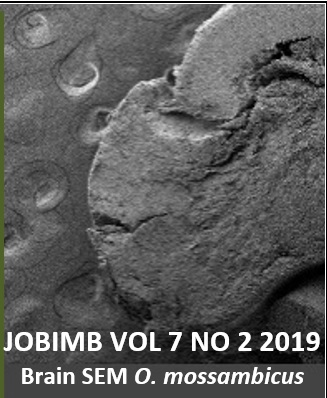Screening of Anti-Quorum Sensing Activity from Selected Chinese Herbs Against Chromobacterium violaceum
DOI:
https://doi.org/10.54987/jobimb.v7i2.478Keywords:
Chromobacterium violaceum; Anti-quorum sensing; Quorum Sensing; Chinese herbs; Antibiotic resistanceAbstract
Overuse of antibiotics was contributed to the increasing of bacterial infection resistance against antibiotics and caused a serious issue to the public health. Anti-quorum sensing is a new alternative ways or treatments to fight bacterial pathogenicity. Traditional Chinese herbs were screened of their anti-quorum sensing activities. Six selected traditional Chinese herbs were screened for a simple anti-quorum sensing activity by using Chromobacterium violaceum as the biomonitor. Two out of these herbs were found to be able to exhibit anti-quorum sensing properties; Lycium barbarum and Zingiber officinale. Extraction from Lycium barbarum has stronger anti-quorum sensing activity than Zingiber officinale. Colonies of biomonitor C. violaceum treated with Lycium barbarum almost fully loss its purple pigment. The loss and lack of purple colour from the colonies of C. violaceum indicated that quorum sensing activity was inhibited by the herb’s extracted. It is believed that this herb contains rich source of compounds to fight or control pathogenic bacteria and potentially a new therapeutic way to reduce the development of antibiotic resistanc
References
Livermore DM. Discovery research: The scientific challenge of finding new antibiotics. J Antimicrob Chemother. 2011; 66(9):1941–4.
Silver LL. Challenges of antibacterial discovery. Clin Microbiol Rev. 2011; 24(1):71–109.
Newman DJ, Cragg GM, Snader KM. Natural products as sources of new drugs over the period 1981 to 2002. J Nat Prod. 2003; 66(7):1022-37.
Miller MB, Bassler BL. Quorum sensing in bacteria. Ann Rev Microbiol. 2001; 55:165-199.
Lowery CA, Dickerson TJ, Janda KD. Interspecies and interkingdom communication mediated by bacterial quorum sensing. Chem Soc Rev. 2008; 37(7):1337-1346.
Sun J, Daniel R, Wagner-Dobler I, Zeng AP. Is autoinducer-2 a universal signal for interspecies communication: A comparative genomic and phylogenetic analysis of the synthesis and signal transduction pathways. BMC Evol Biol. 2004; 4(1):36-46.
Stauff DL, Bassler BL. Quorum sensing in Chromobacterium violaceum: DNA recognition and gene regulation by the CviR receptor. J Bacteriol. 2011; 193(15):3871-3878.
Hentzer M, Givskov M. Pharmacological inhibition of quorum sensing for the treatment of chronic bacterial infections. J Clin Invest. 2003; 112(9):1300-7.
Zhang L, Lin J, Ji G. Membrane anchoring of the AgrD N-terminal amphipathic region is required for its processing to produce a Quorum sensing pheromone in Staphylococcus aureus. J Biol Chem. 2004. 279(19): 19448-19456.
Barry P. Prescription Drug Side Effects. AARP. 2011; Retrieved from http://www.aarp.org/health/drugs-supplements/info-09-2011/prescription-drug-side-effects.html.
Suga H, Smith KM. Molecular mechanisms of bacterial quorum sensing as a new drug target. Curr Opin Chem Biol. 2003; 7(5):586–591.
Breah L, Michael JF. Exploiting Quorum Sensing to Confuse Bacterial Pathogens. Microbiol. Mol. Biol. Rev. 2013; 77(1):73-111.
Ergil KV, Kramer EJ, Ng AT. Chinese herbal medicines. Western Journal of Medicine. 2002; 176(4):275–279.
Adonizio AL, Downum K, Bennett BC, Mathee K. Anti-quorum sensing activity of medicinal plants in southern Florida. J Ethnopharmacol. 2006; 105(3):427-35.
McLean RJ, Pierson LS, Fuqua C. A simple screening protocol for the identification of quorum signal antagonists. J Microbiol Methods. 2004; 58(3):351-360.
Hani ZA. Anti-quorum sensing natural compounds. J Microsc Ultrastruct. 2018; 6(1):1-10.
Vattem D, Mihalik K, Crixell S, Mclean R. Dietary phytochemicals as quorum sensing inhibitors. Fitoterapia. 2007; 78(4):302-310.
Chan KG et al. Characterization of N - acylhomoserine lactone - degrading bacteria associated with the Zingiber officinale (ginger) rhizosphere: co-existence of quorum quenching and quorum sensing in Acinetobacter and Burkholderia. BMC Microbiol. 2011; 11:51.
Koh CL, Choon KS, Wai FY, Li YT, Thiba K, Yee MC, Kok GC. Plant-Derived Natural Products as Sources of Anti-Quorum Sensing Compounds. Sensors. 2013; 13(5):6217-28.
Downloads
Published
How to Cite
Issue
Section
License
Authors who publish with this journal agree to the following terms:
- Authors retain copyright and grant the journal right of first publication with the work simultaneously licensed under a Creative Commons Attribution License (http://creativecommons.org/licenses/by/4.0) that allows others to share the work with an acknowledgement of the work's authorship and initial publication in this journal.
- Authors are able to enter into separate, additional contractual arrangements for the non-exclusive distribution of the journal's published version of the work (e.g., post it to an institutional repository or publish it in a book), with an acknowledgement of its initial publication in this journal.
- Authors are permitted and encouraged to post their work online (e.g., in institutional repositories or on their website) prior to and during the submission process, as it can lead to productive exchanges, as well as earlier and greater citation of published work (See The Effect of Open Access).



